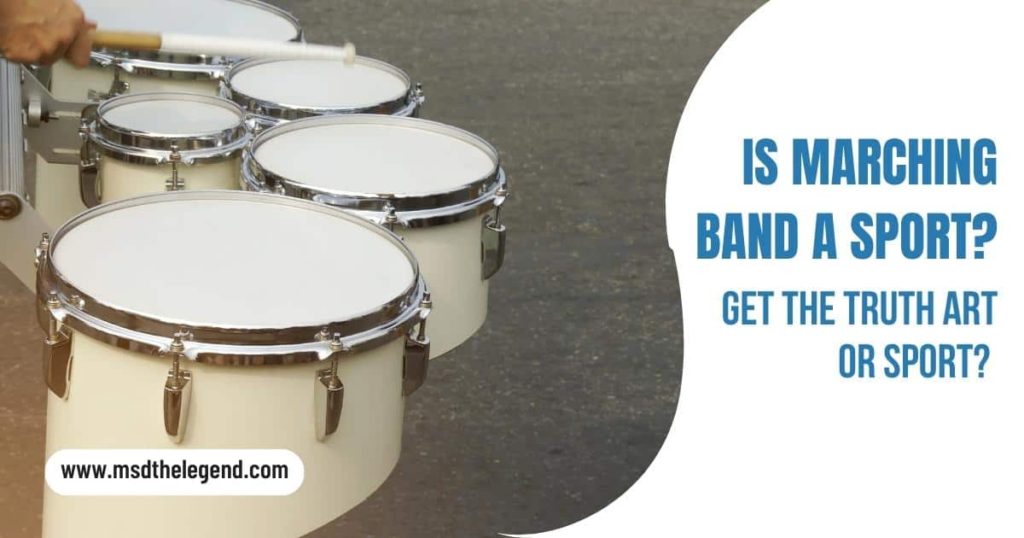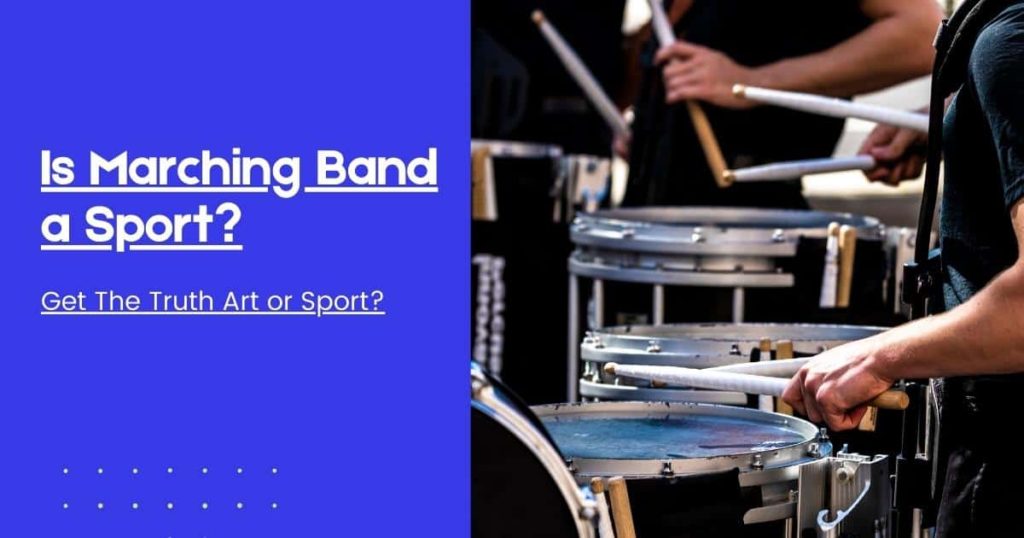When we think of sports, the image of athletes competing on fields, courts, or tracks often comes to mind. However, there are many activities that fall into a gray area when it comes to their classification as sports. One such activity is marching band, which showcases artistic and athletic elements in a unique way. In this article, we will explore the debate surrounding the status of marching band as a sport, examining its physical demands, competitive aspects, benefits, and challenges. Let’s dive into the intricacies of this captivating activity.
Understanding the Definition of a Sport
Before delving into the specific arguments related to marching band, it’s crucial to grasp the definition of a sport. A sport is generally considered an activity involving physical exertion and skill, governed by a set of rules, and conducted in a competitive manner. While traditional sports like football and basketball fit neatly into this definition, activities like chess and esports have also been recognized as sports due to their competitive nature and skill requirements.
Debating Marching Band’s Classification
The question of whether marching band qualifies as a sport has sparked numerous discussions among enthusiasts, educators, and sports enthusiasts alike. Proponents argue that marching band fulfills the criteria of physical exertion, skill, and competition, making it a legitimate sport. However, others are skeptical, perceiving it as more of an art form than a sport. To gain a better perspective, let’s consider both sides of the argument.
Is Marching Band a Sport?
Advocates of marching band as a sport highlight the rigorous physical demands placed on participants. Marching bands often perform intricate formations and maneuvers, requiring precise footwork, coordination, and stamina. Members must memorize complex routines and execute them flawlessly, akin to athletes mastering their plays on the field. Moreover, during parades and competitions, they must perform while carrying heavy instruments, adding an extra layer of physical challenge.
Is Marching Band Considered a Sport?
On the contrary, some individuals contend that while marching band involves physical activity, it should be considered more as an art form or performing art than a sport. They emphasize the artistic expression, creativity, and musical aspects of the activity, which distinguish it from traditional sports. Marching bands often collaborate with color guards and musicians to craft captivating visual and auditory performances, akin to a carefully choreographed theater production.
Examining the Physical Demands of Marching Band
To address the question of whether marching band is a sport, it is essential to closely examine the physical requirements of its participants. Marching band members undergo rigorous training and rehearsals, with practices often stretching for hours. These sessions build physical fitness, endurance, and muscle memory, akin to athletes preparing for their games. Additionally, the intricate footwork, constant movement, and musical synchronization demand a high level of athleticism.
The Competitive Aspect of Marching Bands
One aspect that blurs the line between marching band and traditional sports is the competitive nature of marching band performances. Marching bands participate in various competitions and tournaments, showcasing their skills and creativity to impress judges and spectators alike. These events often involve multiple bands from different schools or regions, fostering a sense of healthy competition and camaraderie.
Competitions and Tournaments
Marching band competitions are vibrant and lively events where bands compete head-to-head. Judges assess various elements, including musicality, marching technique, visual effects, and overall presentation. Bands strive to outperform each other, fueling a competitive spirit that mirrors traditional sports rivalries. These competitions provide an opportunity for bands to demonstrate their hard work, dedication, and talent to a wider audience.
Scoring and Judging Criteria
In marching band competitions, scoring is based on objective criteria, much like scoring in sports. Judges are trained professionals who evaluate performances using standardized guidelines. They assign scores for different aspects of the show, such as music, visual performance, and general effect. This objectivity adds a competitive edge to marching band events, aligning them with traditional sports competitions.
Benefits of Marching Band as a Sport
While the debate about marching band’s status continues, there is no denying the multitude of benefits it offers to its participants. Marching band, whether classified as a sport or not, provides valuable life skills and experiences that positively impact individuals.
Physical Fitness and Coordination
Participating in marching band requires consistent physical activity, leading to improved cardiovascular health, muscular strength, and flexibility. The precise footwork and coordination involved enhance motor skills and body control. This aspect of marching band aligns with the physical fitness benefits gained from engaging in traditional sports.
Teamwork and Leadership Skills
Marching bands epitomize the essence of teamwork. Every member plays a crucial role in the collective performance, and success depends on seamless collaboration. Participants learn to communicate effectively, resolve conflicts, and support one another, fostering a strong sense of camaraderie. Leadership opportunities within the band also enable individuals to develop essential leadership skills that extend beyond the field or stage.
Discipline and Time Management
Succeeding in marching band necessitates discipline and dedication. Members must attend regular rehearsals, adhere to a strict schedule, and put in consistent effort to improve. Such discipline instills time management skills that are transferable to academic pursuits and future careers. Additionally, participants learn the value of perseverance and hard work as they strive for excellence.


Is Colorguard a Sport? Debunking the Myths and Celebrating the Artistry in 24

Addressing the Critics
Despite the evident benefits and competitive nature of marching band, it still faces criticism and skepticism regarding its classification as a sport. To address these concerns, it is crucial to debunk misconceptions and emphasize the broader role of arts and creativity in education.
Misconceptions about Marching Band
One common misconception about marching band is that it lacks the physical rigor and athleticism of traditional sports. However, as we have explored earlier, marching band participants undergo intense training and physical demands that rival those of many sports. The precision and coordination required for marching band routines demonstrate the participants’ athleticism and dedication.
Another misconception is that marching band is merely a recreational activity or a form of entertainment with little educational value. In reality, marching band provides valuable learning experiences that go beyond musical and artistic skills. Participants learn essential life skills such as teamwork, discipline, time management, and leadership, which are applicable in various aspects of life.
The Importance of Arts in Education
Advocating for the recognition of marching band as a sport does not diminish the significance of the arts in education. The arts play a vital role in fostering creativity, critical thinking, and emotional expression in students. They provide a well-rounded education that complements academic subjects and nurtures well-rounded individuals.
Music and arts programs have been shown to enhance cognitive development, improve academic performance, and boost students’ self-esteem. Thus, advocating for marching band as a sport is not about diminishing its artistic value but rather recognizing its athletic aspects and the valuable skills it cultivates in its participants.
Comparing Marching Band to Traditional Sports
To gain a deeper understanding of the sport debate surrounding marching band, let’s compare some key aspects between marching band and traditional sports.
Athleticism and Artistry
Traditional sports often prioritize physical strength, speed, and agility. On the other hand, marching band emphasizes precise movements, coordination, and artistic expression. While the physical demands may differ, both activities require dedication, practice, and teamwork.
Community and School Spirit
Marching bands play a significant role in fostering a sense of community and school spirit. They perform at school events, pep rallies, parades, and football games, becoming a source of pride and unity for the entire school. This spirit and camaraderie align with the unifying effect of traditional sports on communities.
Challenges Faced by Marching Bands
Despite its merits, marching bands encounter unique challenges that can affect their recognition and sustainability as a sport.
Funding and Support
Many marching bands face financial constraints, as the costs associated with instruments, uniforms, travel, and competition fees can be significant. Limited funding can hinder access to quality instruction and resources, impacting the band’s overall performance and competitiveness.
Balancing Academics and Extracurricular Activities
Marching band participants often face the challenge of balancing their academic responsibilities with the time commitments required for rehearsals and performances. Striking this balance can be demanding, but it also teaches valuable time management and prioritization skills.
Inclusivity and Diversity in Marching Bands
Efforts to promote inclusivity and diversity within marching bands have gained momentum in recent years. Traditionally, marching bands have been perceived as predominantly white and male. However, the push for inclusivity aims to break down barriers and welcome participants from all backgrounds.
Breaking Stereotypes
Marching bands are actively working to dispel stereotypes associated with gender and race. Encouraging representation from diverse backgrounds fosters an environment of acceptance and appreciation for individual differences.
Encouraging Participation for All
Inclusivity in marching bands means providing opportunities for all students to participate, regardless of their musical background or experience. Some bands offer beginner programs or workshops to attract newcomers, ensuring that everyone has the chance to explore their musical talents.
The Future of Marching Bands as a Sport
As marching bands continue to evolve, their future as a recognized sport appears promising.
Growth and Evolution
Marching bands are evolving, embracing new technologies, and integrating contemporary music and themes into their performances. This evolution allows them to appeal to a broader audience while preserving their artistic and athletic foundations.
Cultural Impact
Marching bands hold a significant cultural impact, not only within school communities but also in society at large. They celebrate cultural diversity through their performances, showcasing various musical styles and traditions.

Why Is Marching Band Not a Sport? Debunking Misconceptions
Marching band, a captivating activity that combines music, precision movements, and visual flair, has been a subject of debate when it comes to its classification as a sport. While some argue that marching band fulfills the criteria of physical exertion, skill, and competition, others contend that it should be considered more as an art form than a sport. In this article, we will delve into the reasons why marching band is not universally recognized as a sport and address common misconceptions associated with its status.
Understanding the Definition of a Sport
Before delving into the reasons why some do not consider marching band a sport, let’s revisit the definition of a sport. A sport is generally described as an activity involving physical exertion and skill, governed by a set of rules, and conducted in a competitive manner. It is crucial to bear this definition in mind when examining the characteristics of marching band and its potential classification.
Artistic Expression vs. Athletic Competition
One of the primary reasons why some do not classify marching band as a sport is the emphasis on artistic expression and creativity. While traditional sports focus on athletic competition and physical prowess, marching band prioritizes precise movements, musicality, and visual effects. The artistic elements of marching band performances often take center stage, distinguishing it from the competitive nature of traditional sports.
Critics argue that the subjective nature of artistic interpretation in marching band routines contrasts with the objective scoring criteria found in traditional sports. In sports such as basketball or soccer, points are awarded for goals scored or baskets made, leaving little room for subjectivity. In contrast, marching band performances are evaluated based on judges’ opinions and individual interpretations, making it more akin to a performing art than a sport.
Lack of Head-to-Head Competition
Another factor contributing to the view of marching band as not being a sport is the absence of direct head-to-head competition. In many traditional sports, teams or individuals compete directly against each other, with the outcome determined by the results of the game or match. Marching band competitions, on the other hand, involve bands performing individually and being evaluated independently.
While there are competitive elements in marching band events, such as achieving higher scores than other bands, the absence of a direct opponent in real-time play sets it apart from conventional sports. Some argue that this distinction places marching band more in the realm of a performance art rather than a competitive sport.
Athleticism vs. Physical Activity
The debate over whether marching band should be classified as a sport also hinges on the distinction between athleticism and physical activity. While it is undeniable that marching band requires physical activity, such as marching, playing musical instruments, and executing complex routines, critics argue that this alone does not qualify it as a sport.
Traditional sports often demand specific physical attributes such as speed, strength, and agility. In contrast, marching band may require different physical skills, such as endurance, coordination, and flexibility. While these qualities are valuable and commendable, they do not necessarily align with the traditional definition of athleticism found in mainstream sports.
Funding and Recognition
The lack of official recognition and funding for marching bands as sports in some educational institutions also contributes to the perception of marching band as not being a sport. In many schools, sports teams receive more financial support, resources, and attention compared to marching bands.
The disparity in funding can affect the quality of instruction, equipment, and opportunities available to marching band members. Without the same level of investment as traditional sports, marching bands may struggle to attain the recognition and status enjoyed by athletic teams.
Inconsistent Classification Across Institutions
The classification of marching band as a sport varies significantly among different institutions and governing bodies. While some schools and organizations consider it a sport and provide it with the same resources and support, others categorize it as an extracurricular activity or performing art.
This inconsistency in classification leads to differing levels of recognition and opportunities for marching band participants. The lack of a standardized approach to classifying marching band further fuels the debate over its status as a sport.
Addressing Misconceptions
Despite the arguments against classifying marching band as a sport, it is essential to address common misconceptions that may contribute to the debate.
Misconception 1: Marching Band Requires Little Physical Exertion
One common misconception is that marching band involves minimal physical exertion compared to traditional sports. In reality, marching band participants undergo rigorous training and rehearsals, which demand physical stamina, endurance, and precision.
The intricate footwork, constant movement, and synchronization required during performances demonstrate the physical demands placed on marching band members. The physical challenges of marching band are comparable to those of certain sports, challenging the notion that it lacks athleticism.
Misconception 2: Marching Band Lacks Competitive Elements
While the head-to-head competition may not be as evident in marching band as in traditional sports, it still possesses competitive elements. Marching bands compete in various competitions and tournaments, aiming to impress judges and outperform other bands.
The scoring and judging criteria used in marching band competitions add an objective and competitive dimension to the activity. Bands strive to excel and achieve high scores, mirroring the competitive spirit found in sports.
Misconception 3: Marching Band Offers Limited Educational Value
Some critics argue that marching band provides limited educational value compared to sports. However, participating in marching band offers numerous benefits beyond musical and artistic skills.
Marching band participants learn valuable life skills, such as teamwork, discipline, time management, and leadership. These skills are transferable to academic pursuits and future careers, contributing to the overall development of individuals.

Understanding Kho Kho Ground Measurement | Kho Kho Sports History in (Updated) 2024

How To GHD Sports IPL Live 2020 Latest (August Updated) Ind Vs West Indies?

Creating Top-notch Sports Facilities in Schools: Building a Sports Facility in 24-25
Exploring the Essentials of Marching Band: Color Guard, Drill, Camp, and Origin
Marching band is a captivating and dynamic art form that combines music, precision movements, and visual elements. As a multifaceted activity, marching band involves several key components that contribute to its overall performance and success. In this article, we will explore the essentials of marching band, including the Color Guard, Drill, Camp, and delve into the intriguing history of when marching band was invented.
What Is Marching Band Color Guard?
The Color Guard is an integral part of a marching band performance, adding visual flair and enhancing the overall presentation. It comprises performers who carry and manipulate various pieces of equipment, such as flags, rifles, sabers, and other props, in synchronization with the music and marching movements of the band.
The Role of the Color Guard
The Color Guard serves multiple roles in a marching band production. One of its primary functions is to visually interpret the music, enhancing the emotional impact of the performance. Through precise movements and choreography, the Color Guard conveys the themes, moods, and narratives of the music, creating a captivating visual experience for the audience.
In addition to enhancing the artistic aspect of the performance, the Color Guard also serves a practical function during parades and field shows. It acts as a guide for the band members, helping them maintain proper formations and stay in alignment during complex marching maneuvers.
Training and Skill Development
Participation in the Color Guard requires significant training and skill development. Performers must master various techniques, including spinning flags, tossing rifles, and executing intricate dance movements. The coordination, timing, and precision required in Color Guard performances demand rigorous rehearsals and practice.
What Is Marching Band Drill?
Marching band drill refers to the intricate and precisely choreographed formations and movements performed by the band members during a field show or parade. The drill determines the positioning and spacing of each band member on the field and outlines the pathways they follow throughout the performance.
Designing the Drill
Creating a marching band drill is a complex and artistic process. Drill designers use specialized software to visualize and plan the movements of each band member. They take into account the musical phrasing, tempo changes, and the overall artistic vision of the performance.
The drill designer’s goal is to craft visually engaging and dynamic formations that complement the music and convey the intended themes of the show. The precision and accuracy of the drill are crucial to achieving a seamless and visually stunning performance.
Learning and Execution
Once the drill is designed, the band members begin the learning and rehearsal process. They memorize their individual movements and positions on the field, ensuring that each step and turn aligns perfectly with the music.
Band directors and drill instructors play a pivotal role in guiding the band members through the learning process. They provide feedback, correct mistakes, and fine-tune the performance to achieve synchronization and unity among all performers.
What Is Marching Band Camp?
Marching band camp is an intensive and immersive training program that takes place before the start of the marching band season. It provides band members with an opportunity to prepare for the upcoming performances, build camaraderie, and strengthen their skills.
Preparing for the Season
Marching band camp typically occurs during the summer months, allowing band members to dedicate focused time to rehearsals and preparation. During the camp, students learn and perfect the music and drill for the field shows and parades they will perform throughout the season.
The camp also serves as a time for band members to bond and establish a sense of unity within the ensemble. The friendships and teamwork developed during camp contribute to a positive and supportive atmosphere throughout the marching season.
Rigorous Training and Conditioning
Marching band camp involves rigorous training and conditioning to prepare students physically and mentally for the demands of the season. Band members engage in daily rehearsals, physical exercises, and practice sessions to build endurance, improve their musical skills, and refine their marching technique.
The long hours and intense practice schedule during camp simulate the demands of the marching band season, ensuring that students are well-prepared for performances and competitions.
When Was Marching Band Invented?
The history of marching band can be traced back to ancient times, where military units used music and coordinated movements to convey orders and create a sense of unity among troops. However, the modern concept of marching bands as a form of artistic performance and entertainment emerged in the late 19th and early 20th centuries.
Military Origins
The origins of marching bands can be found in military music and parades. Military bands have long played a critical role in military ceremonies and drills, using music to inspire and motivate soldiers. As military units began to adopt more standardized marching formations and drills, music became an integral part of the marching experience.
Evolution into Artistic Performances
As military bands evolved, they began incorporating more artistic elements into their performances. The inclusion of visual effects, such as synchronized marching and flag waving, transformed military bands into engaging and entertaining spectacles.
The advent of drum and bugle corps in the early 20th century further contributed to the development of marching bands as a form of artistic expression. These groups focused on precision marching and musical excellence, paving the way for modern marching band performances.
Expansion into Schools and Universities
In the early 20th century, marching bands began to gain popularity in educational settings, particularly in schools and universities. Schools started forming marching bands as a way to promote school spirit, provide entertainment at sporting events, and showcase student musical talent.
Over time, marching bands in educational institutions evolved into sophisticated ensembles, incorporating various visual elements such as color guard and drill formations. Today, marching bands continue to thrive as a prominent part of the American musical and cultural landscape.
Marching Band: A Symphony of Skill, Teamwork, Endurance, and Artistry
Marching band is a captivating and dynamic art form that brings together music, precision movements, and visual elements to create breathtaking performances. It is a collective effort that requires a diverse range of skills from its participants. In this article, we will delve into the various skills and qualities that marching band members must possess to excel in this enriching and challenging activity.
Does Marching Band Require Skill?
Without a doubt, marching band demands a high level of skill from its participants. From musicians to Color Guard performers, every member of the ensemble plays a crucial role in creating a cohesive and visually stunning performance.
Musical Proficiency
For instrumentalists, musical proficiency is a fundamental requirement. Marching band members must be skilled in playing their instruments while maintaining proper intonation, tone quality, and musical expression. They must be able to read sheet music, interpret dynamic markings, and execute complex musical passages accurately.
Precision in Movements
Marching band involves intricate choreography and precise movements. Members must march in step with one another, maintaining consistent intervals and formations throughout the performance. This level of precision requires focus, concentration, and the ability to execute movements flawlessly.
Marching Band Requires Teamwork
A successful marching band performance is the result of seamless teamwork among all its members. Each individual’s contribution is essential to create a unified and harmonious display.
Communication and Coordination
Effective communication is vital in marching band. Members must be able to receive and understand directions from the conductor or drum major, responding promptly to cues and changes in the performance. This level of coordination ensures that everyone is in sync, contributing to the overall success of the ensemble.
Support and Collaboration
Teamwork in marching band extends beyond the music. Color Guard performers, for instance, rely on the support and coordination of their fellow members to execute their routines and enhance the visual aspects of the performance. The sense of camaraderie and collaboration within the band fosters a positive and supportive environment.
Marching Band Requires Endurance
Participating in a marching band requires physical and mental endurance. Band members engage in lengthy rehearsals and performances that demand stamina and perseverance.
Physical Fitness
The physical demands of marching band should not be underestimated. Members must march long distances, often while carrying instruments or equipment. This requires physical fitness and endurance to maintain energy levels throughout rehearsals and performances.
Mental Fortitude
Endurance in marching band also pertains to mental resilience. Members must remain focused and attentive during extended rehearsals, adapting to changes in the performance, and persevering through challenging sections of the show.
Marching Band Requires Knowledge and Technique
To excel in marching band, participants must possess a strong foundation of knowledge and technique related to music, movement, and performance.
Music Theory and Interpretation
Musicians in marching band benefit from a solid understanding of music theory. This knowledge enables them to interpret musical notation, dynamics, and phrasing, enhancing their ability to perform with expressiveness and precision.
Marching Technique
Marching band members must learn and master specific marching techniques, including proper foot placement, posture, and arm movement. The precision and alignment of these movements contribute to the overall visual impact of the performance.

Marching Band Requires Flexibility, Timing, and Rhythm
Flexibility, timing, and rhythm are essential elements of marching band performances, contributing to the fluidity and synchronicity of the ensemble.
Flexibility in Movement
Marching band members must be flexible in adapting to various formations and choreography. Quick and precise transitions between formations require agility and flexibility.
Timing and Rhythm
Accurate timing and rhythm are crucial in marching band. Every member must maintain a steady tempo, aligning their movements and musical phrases precisely. Proper timing ensures that the band moves as one cohesive unit.
Are Marching Band Members Athletes? Debunking Misconceptions and Celebrating Their Skills
Marching band is a captivating and dynamic activity that combines music, precise movements, and visual flair to create mesmerizing performances. While there is no denying the physical demands and skill required, the classification of marching band members as athletes remains a topic of debate. In this article, we will explore the athleticism of marching band members, the competitive nature of the activity, its role in providing entertainment, the potential for injuries, and the reasons why it is not considered an Olympic sport.
Are Marching Band Members Athletes?
The question of whether marching band members are athletes hinges on the definition of athleticism and the physical demands of the activity. Athletes are generally defined as individuals who participate in physical sports or exercises that require strength, endurance, and skill.
Physical Demands of Marching Band
Marching band members undergo rigorous training and physical activity throughout rehearsals and performances. They must march in precise formations, execute complex choreography, and play musical instruments simultaneously. This demands stamina, coordination, and precision.
The physical demands of marching band are comparable to those of certain sports, such as cross-country running, gymnastics, or dance. As such, many argue that marching band members should be recognized as athletes for their athleticism and dedication.
Marching Band is Competitive
Marching band involves a competitive aspect, where ensembles from different schools or organizations compete against each other. Competitions are typically judged by a panel of experts who assess various elements, including musicality, visual effects, and overall performance.
Preparation for Competitions
To prepare for competitions, marching bands engage in intense rehearsals and fine-tuning of their routines. They strive to achieve precision and excellence in their movements and musical execution. The competitive nature of marching band motivates members to continuously improve and excel in their performances.
Marching Band Provides Entertainment and Enjoyment to an Audience
Beyond the competitive aspect, marching band serves as a form of entertainment that brings joy and excitement to audiences. Whether at sporting events, parades, or concerts, marching bands captivate spectators with their musical talents and visually stunning performances.
School Spirit and Community Engagement
Marching bands play a significant role in boosting school spirit and fostering a sense of community. They perform at school events, pep rallies, and football games, uniting students, faculty, and alumni in a shared sense of pride and enthusiasm.
Cultural Celebrations and Festivities
In addition to school events, marching bands are often featured in cultural celebrations and public festivals. Their diverse and vibrant performances showcase various musical styles and traditions, contributing to the cultural richness of the events.
Can You Get Injured in Marching Band?
Like any physical activity, marching band carries a risk of injuries, although they are typically less common and severe than those seen in contact sports. Injuries can result from various factors, including marching and maneuvering on different terrains, playing musical instruments, and performing complex choreography.
Common Injuries
Some common injuries in marching band may include sprains, strains, overuse injuries, and minor bruises from marching and repetitive movements. Musicians may also experience conditions related to their instrument, such as repetitive stress injuries in the wrists and hands.
Preventing Injuries
To minimize the risk of injuries, marching band programs focus on proper warm-up and stretching routines, maintaining good posture during performances, and providing adequate rest and recovery for members. Band directors and instructors play a crucial role in ensuring the safety and well-being of the participants.


The Least Hottest Sports: Finding the Perfect Match for You in 24

Win Win Sport Betting: Embracing a New Era of Sports Wagering in 24
Is Marching Band an Olympic Sport?
As of the time of writing, marching band is not recognized as an Olympic sport. The Olympic Games feature a wide range of athletic competitions, from traditional sports to more niche disciplines. However, the inclusion of new sports in the Olympic program is periodically reviewed and decided by the International Olympic Committee (IOC).
Criteria for Olympic Recognition
To be considered for inclusion in the Olympics, a sport must meet certain criteria set forth by the IOC. Some of these criteria include having an international governing body, widespread participation across multiple countries, and adherence to the Olympic Charter’s principles.
While marching band has a competitive aspect and international participation, it has not yet met the specific criteria for inclusion in the Olympic Games.
Why is Marching Band Not Considered a Sport?
The classification of marching band as a sport remains a subject of debate and varies depending on different perspectives and definitions of sport.
Artistic Expression vs. Competitive Sport
One of the primary reasons marching band is not universally considered a sport is the emphasis on artistic expression and creativity. While it shares certain elements with sports, such as physical exertion and competition, the artistic aspects of marching band distinguish it from traditional competitive sports.
Lack of Direct Head-to-Head Competition
Unlike many sports where teams or individuals compete directly against each other, marching band competitions involve bands performing individually and being evaluated independently. While they may aim to achieve higher scores than other bands, the lack of a direct opponent in real-time play sets marching band apart from conventional sports.
Varied Classification Across Institutions
The classification of marching band varies significantly among different institutions and governing bodies. While some schools and organizations consider it a sport and provide it with the same resources and support, others categorize it as an extracurricular activity or performing art.
Conclusion
In conclusion, the debate over whether marching band is a sport highlights the unique and multi-faceted nature of this activity. While its artistic expression and creativity are undeniable, marching band also encompasses the physical demands, competition, and team dynamics found in traditional sports. Regardless of its classification, marching band offers numerous benefits, including physical fitness, teamwork, discipline, and creativity. As we continue to appreciate the artistic and athletic aspects of marching bands, it is essential to support these programs and recognize their invaluable contribution to education and the community.
Marching band is a magnificent symphony of skill, teamwork, endurance, knowledge, technique, flexibility, timing, and rhythm. Its participants showcase their musical proficiency, precision in movements, and ability to work as a team to create awe-inspiring performances.
The dedication and hard work of marching band members culminate in mesmerizing displays that captivate audiences and showcase the artistic prowess of the ensemble. From musicians to Color Guard performers, each individual’s contribution is essential to the success of the band as a whole.
Beyond the musical and visual spectacle, marching band instills valuable life skills such as discipline, teamwork, and resilience. It fosters a sense of camaraderie and creates lasting memories and friendships among its members.
In the end, marching band is more than just an extracurricular activity; it is an immersive and enriching experience that leaves a lasting impact on the lives of its participants and those who have the privilege of witnessing their harmonious performances.
Marching band is a multifaceted and captivating activity that combines music, precision movements, and visual elements. The Color Guard adds visual flair to performances, while the Drill outlines the intricate formations and movements on the field. Marching band camp provides intensive training and camaraderie for band members, preparing them for the demanding season ahead.
The history of marching band traces back to military origins, evolving into artistic performances and finding a prominent place in schools and universities. As a dynamic and ever-evolving art form, marching band continues to delight audiences, inspire performers, and showcase the talent and dedication of its participants.
The debate over whether marching band qualifies as a sport stems from differing interpretations of the term “sport” and the emphasis on artistic expression and creativity in marching band performances. While marching band shares some characteristics with traditional sports, such as physical activity, competition, and teamwork, it also possesses unique elements that distinguish it as a performing art.
Addressing common misconceptions and recognizing the physical demands and competitive nature of marching band can foster a more comprehensive understanding of this captivating activity. Regardless of its classification, marching band continues to enrich the lives of its participants, providing valuable skills and experiences that contribute to their personal and artistic growth.
Marching band members display athleticism, skill, and dedication through their rigorous training and performances. The competitive nature of marching band fosters excellence and camaraderie among its members. As a form of entertainment, marching band delights audiences and plays a vital role in school spirit and community engagement.
While injuries can occur in any physical activity, preventive measures are implemented to ensure the safety and well-being of marching band participants. As for its status as an Olympic sport, marching band has yet to meet the specific criteria for inclusion in the prestigious international event.
The classification of marching band as a sport remains a subject of debate due to its unique blend of artistic expression and physical demands. Ultimately, marching band stands as a captivating and rewarding activity that showcases the talent, dedication, and artistic prowess of its members.
FAQs
Is Marching Band considered a sport in schools?
The classification of marching band as a sport in schools varies from one institution to another. Some schools recognize marching band as a sport, while others consider it a performing art or extracurricular activity.
What physical skills are required for marching band?
Marching band participants need to possess physical skills such as coordination, endurance, and precision footwork. They must also have the ability to carry and play musical instruments while maintaining proper posture and alignment.
Are there professional marching bands?
While there are no professional marching bands in the traditional sense, some college and university marching bands have gained recognition for their performances and appearances at major events.
How does marching band contribute to school spirit?
Marching bands contribute to school spirit by performing at various school events, rallies, and games. They create a sense of unity and pride among students, faculty, and alumni.
Are there any scholarships available for marching band participants?
Yes, many colleges and universities offer scholarships for talented marching band participants. These scholarships recognize the dedication and skill of the individuals and help support their academic pursuits.






